Answered step by step
Verified Expert Solution
Question
1 Approved Answer
Management Decision Systems (MDS) is a management consulting firm that specialises in the development of mathematical models to help solve marketing- related problems. A
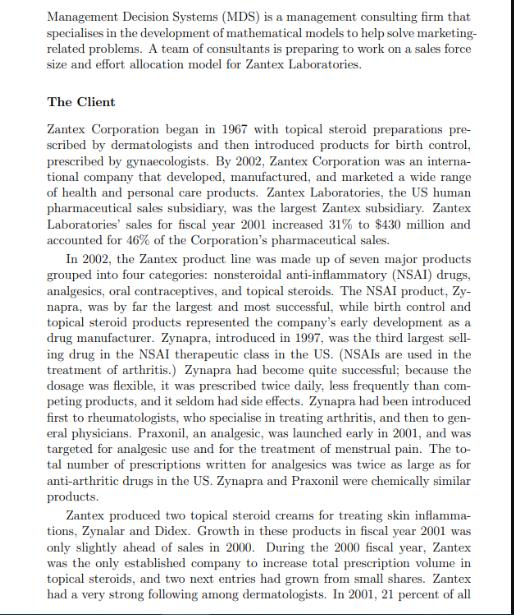

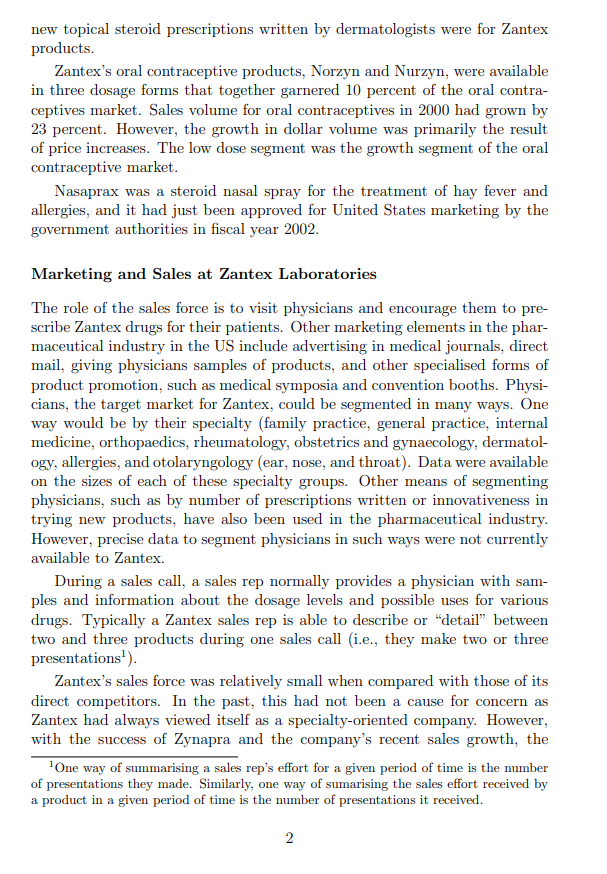
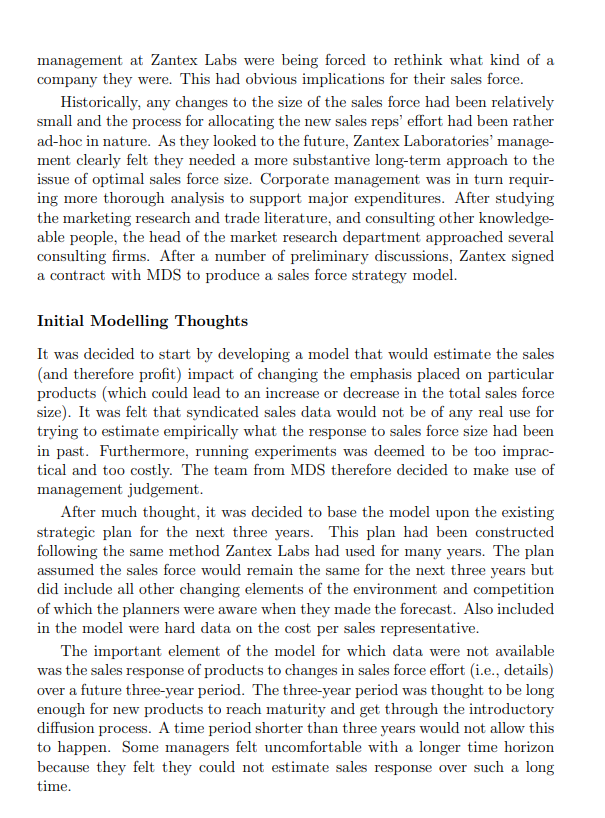
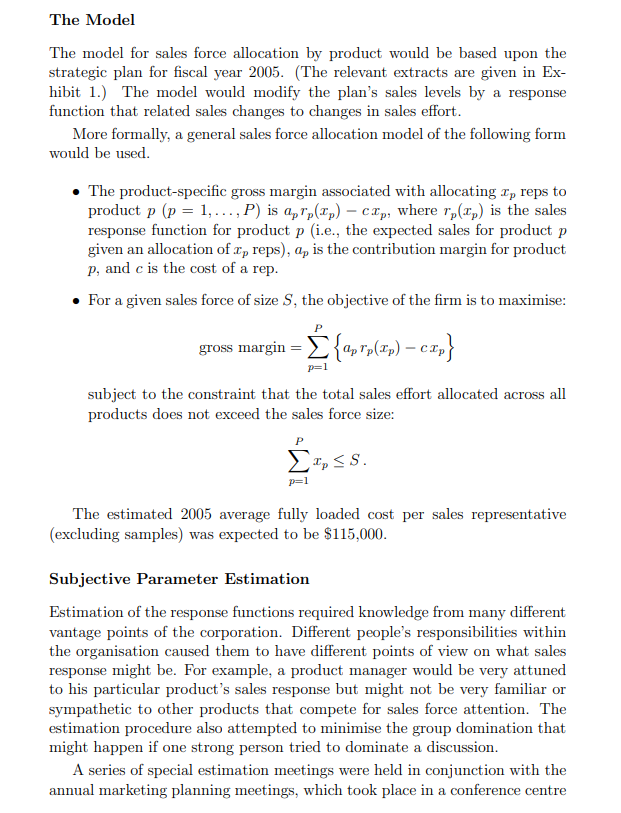

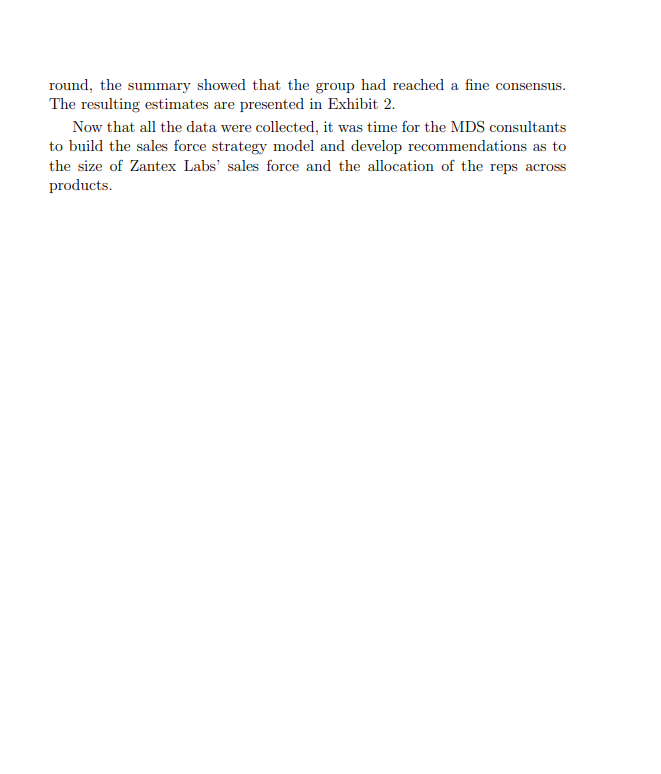
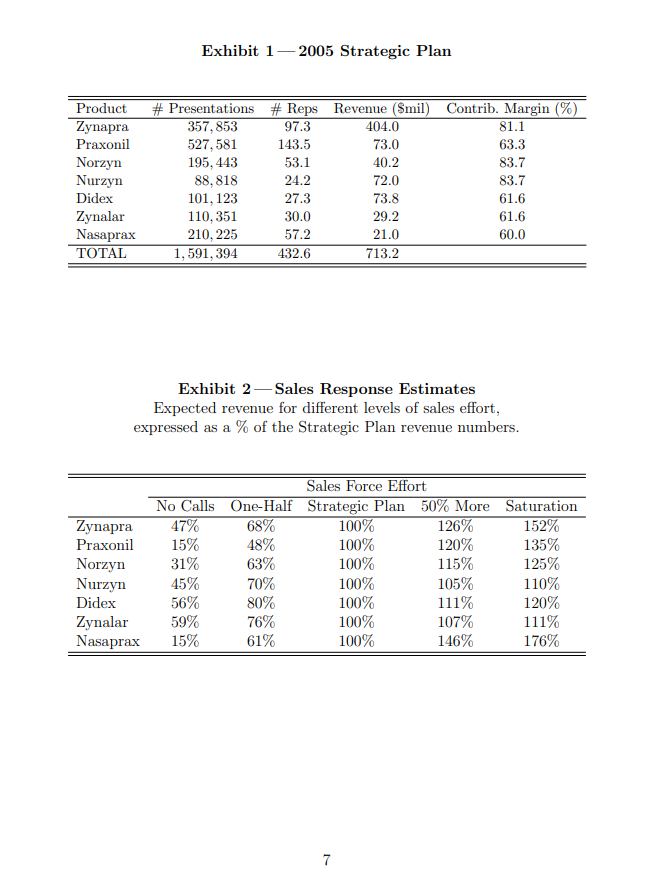

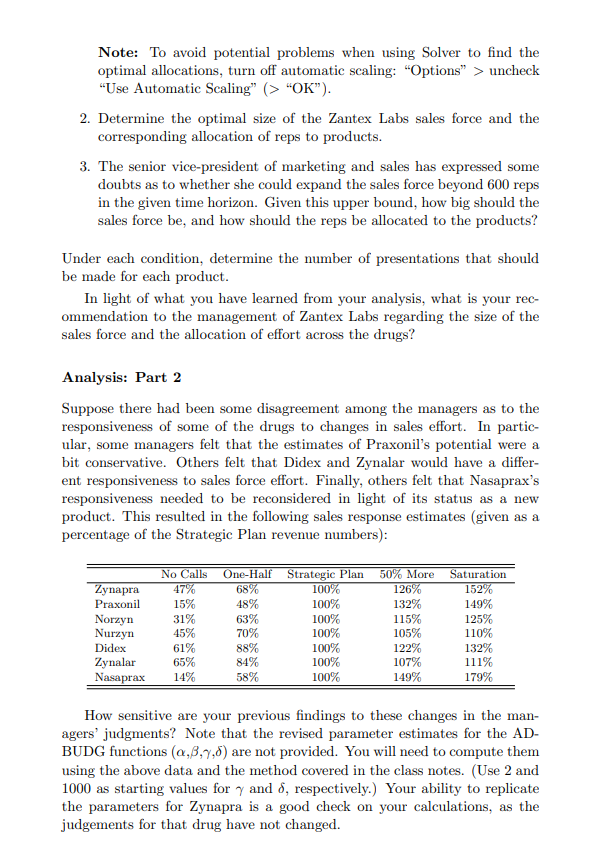
Management Decision Systems (MDS) is a management consulting firm that specialises in the development of mathematical models to help solve marketing- related problems. A team of consultants is preparing to work on a sales force size and effort allocation model for Zantex Laboratories. The Client Zantex Corporation began in 1967 with topical steroid preparations pre- scribed by dermatologists and then introduced products for birth control, prescribed by gynaecologists. By 2002, Zantex Corporation was an interna- tional company that developed, manufactured, and marketed a wide range of health and personal care products. Zantex Laboratories, the US human pharmaceutical sales subsidiary, was the largest Zantex subsidiary. Zantex Laboratories' sales for fiscal year 2001 increased 31% to $430 million and accounted for 46% of the Corporation's pharmaceutical sales. In 2002, the Zantex product line was made up of seven major products grouped into four categories: nonsteroidal anti-inflammatory (NSAI) drugs, analgesics, oral contraceptives, and topical steroids. The NSAI product, Zy- napra, was by far the largest and most successful, while birth control and topical steroid products represented the company's early development as a drug manufacturer. Zynapra, introduced in 1997, was the third largest sell- ing drug in the NSAI therapeutic class in the US. (NSAIS are used in the treatment of arthritis.) Zynapra had become quite successful; because the dosage was flexible, it was prescribed twice daily, less frequently than com- peting products, and it seldom had side effects. Zynapra had been introduced first to rheumatologists, who specialise in treating arthritis, and then to gen- eral physicians. Praxonil, an analgesic, was launched early in 2001, and was targeted for analgesic use and for the treatment of menstrual pain. The to- tal number of prescriptions written for analgesics was twice as large as for anti-arthritic drugs in the US. Zynapra and Praxonil were chemically similar products. Zantex produced two topical steroid creams for treating skin inflamma- tions, Zynalar and Didex. Growth in these products in fiscal year 2001 was only slightly ahead of sales in 2000. During the 2000 fiscal year, Zantex was the only established company to increase total prescription volume in topical steroids, and two next entries had grown from small shares. Zantex had a very strong following among dermatologists. In 2001, 21 percent of all Write-up Your report should summarize the results of your modeling efforts, along with your recommendations to the management of Zantex Labs regarding the size of their sales force and the allocation of their effort. What con- clusions can you draw? What recommendations would you make to the management of Zantex Labs regarding what they should consider in future sales force modeling efforts, using this modeling exercise as a starting point? Your report should be single-spaced; please use margins of at least 2.5 cm. Try to limit your report to no more than 10 pages. Include any impor- tant output from your analyses, along with details of your interpretation of the results and associated calculations. new topical steroid prescriptions written by dermatologists were for Zantex products. Zantex's oral contraceptive products, Norzyn and Nurzyn, were available in three dosage forms that together garnered 10 percent of the oral contra- ceptives market. Sales volume for oral contraceptives in 2000 had grown by 23 percent. However, the growth in dollar volume was primarily the result of price increases. The low dose segment was the growth segment of the oral contraceptive market. Nasaprax was a steroid nasal spray for the treatment of hay fever and allergies, and it had just been approved for United States marketing by the government authorities in fiscal year 2002. Marketing and Sales at Zantex Laboratories The role of the sales force is to visit physicians and encourage them to pre- scribe Zantex drugs for their patients. Other marketing elements in the phar- maceutical industry in the US include advertising in medical journals, direct mail, giving physicians samples of products, and other specialised forms of product promotion, such as medical symposia and convention booths. Physi- cians, the target market for Zantex, could be segmented in many ways. One way would be by their specialty (family practice, general practice, internal medicine, orthopaedics, rheumatology, obstetrics and gynaecology, dermatol- ogy, allergies, and otolaryngology (ear, nose, and throat). Data were available on the sizes of each of these specialty groups. Other means of segmenting physicians, such as by number of prescriptions written or innovativeness in trying new products, have also been used in the pharmaceutical industry. However, precise data to segment physicians in such ways were not currently available to Zantex. During a sales call, a sales rep normally provides a physician with sam- ples and information about the dosage levels and possible uses for various drugs. Typically a Zantex sales rep is able to describe or "detail" between two and three products during one sales call (i.e., they make two or three presentations). Zantex's sales force was relatively small when compared with those of its direct competitors. In the past, this had not been a cause for concern as Zantex had always viewed itself as a specialty-oriented company. However, with the success of Zynapra and the company's recent sales growth, the One way of summarising a sales rep's effort for a given period of time is the number of presentations they made. Similarly, one way of sumarising the sales effort received by a product in a given period of time is the number of presentations it received. 2 management at Zantex Labs were being forced to rethink what kind of a company they were. This had obvious implications for their sales force. Historically, any changes to the size of the sales force had been relatively small and the process for allocating the new sales reps' effort had been rather ad-hoc in nature. As they looked to the future, Zantex Laboratories' manage- ment clearly felt they needed a more substantive long-term approach to the issue of optimal sales force size. Corporate management was in turn requir- ing more thorough analysis to support major expenditures. After studying the marketing research and trade literature, and consulting other knowledge- able people, the head of the market research department approached several consulting firms. After a number of preliminary discussions, Zantex signed a contract with MDS to produce a sales force strategy model. Initial Modelling Thoughts It was decided to start by developing a model that would estimate the sales (and therefore profit) impact of changing the emphasis placed on particular products (which could lead to an increase or decrease in the total sales force size). It was felt that syndicated sales data would not be of any real use for trying to estimate empirically what the response to sales force size had been in past. Furthermore, running experiments was deemed to be too imprac- tical and too costly. The team from MDS therefore decided to make use of management judgement. After much thought, it was decided to base the model upon the existing strategic plan for the next three years. This plan had been constructed following the same method Zantex Labs had used for many years. The plan assumed the sales force would remain the same for the next three years but did include all other changing elements of the environment and competition of which the planners were aware when they made the forecast. Also included in the model were hard data on the cost per sales representative. The important element of the model for which data were not available was the sales response of products to changes in sales force effort (i.e., details) over a future three-year period. The three-year period was thought to be long enough for new products to reach maturity and get through the introductory diffusion process. A time period shorter than three years would not allow this to happen. Some managers felt uncomfortable with a longer time horizon because they felt they could not estimate sales response over such a long time. The Model The model for sales force allocation by product would be based upon the strategic plan for fiscal year 2005. (The relevant extracts are given in Ex- hibit 1.) The model would modify the plan's sales levels by a response function that related sales changes to changes in sales effort. More formally, a general sales force allocation model of the following form would be used. The product-specific gross margin associated with allocating xp reps to product p (p = 1,..., P) is app(Ip) - cxp, where rp (Ip) is the sales response function for product p (i.e., the expected sales for product p given an allocation of xp reps), ap is the contribution margin for product p, and c is the cost of a rep. For a given sales force of size S, the objective of the firm is to maximise: gross margin = {app(Ip) cxp} p=1 subject to the constraint that the total sales effort allocated across all products does not exceed the sales force size: P 55. p=1 The estimated 2005 average fully loaded cost per sales representative (excluding samples) was expected to be $115,000. Subjective Parameter Estimation Estimation of the response functions required knowledge from many different vantage points of the corporation. Different people's responsibilities within the organisation caused them to have different points of view on what sales response might be. For example, a product manager would be very attuned to his particular product's sales response but might not be very familiar or sympathetic to other products that compete for sales force attention. The estimation procedure also attempted to minimise the group domination that might happen if one strong person tried to dominate a discussion. A series of special estimation meetings were held in conjunction with the annual marketing planning meetings, which took place in a conference centre location off-site. The corporate personnel involved in these meetings were the senior vice-president of sales and marketing, the vice-president of sales, two people from the market research department, two product managers, two regional sales managers, and two sales people. The main purpose of the meetings was to come to a group consensus on the likely response of each Zantex product to sales rep effort. On the first day of the annual meeting, worksheets were distributed to the participants that asked them to estimate what change in sales for each of seven Zantex Labs' products would result from different levels of sales rep activity. Each manager responded to the following question for each product: According to the strategic plan, if the current level of sales force is maintained from 2002 to 2005, sales of Product A would be the planned level. What would happen to Product A's 2005 sales (compared to the present levels) if during this same time period it received no sales effort? one half the current sales effort? 50 percent greater sales effort? a saturation level of sales effort? Please express your estimates as a percentage of the planned level of sales for Product A. Each manager filled out their initial response estimates without discussing them with other members of the group. The responses of the group were summarised (including quartiles, medians, and minimum and maximum an- swers for each of the questions). These summaries were then discussed by the group, and those members of the group who were at the far ends of the group norms were encouraged to discuss the reasons for their estimates. The discussion was extremely fruitful because it isolated a lot of the critical assumptions that were necessary for doing a realistic job of response modelling. Elements such as the competitive situation, the role and ability of the sales force to influence physicians, and environmental effects were thoroughly discussed for each product. After this discussion, new worksheets were passed out, and again each person independently developed his or her response judgements, but in this round participants could take into account the discussion and the summary of the previous estimates. After the second round, the summary showed that the group had reached a fine consensus. The resulting estimates are presented in Exhibit 2. Now that all the data were collected, it was time for the MDS consultants to build the sales force strategy model and develop recommendations as to the size of Zantex Labs' sales force and the allocation of the reps across products. Exhibit 1 2005 Strategic Plan Product Zynapra # Presentations #Reps Revenue ($mil) Contrib. Margin (%) 357,853 97.3 404.0 81.1 Praxonil 527,581 143.5 73.0 63.3 Norzyn 195, 443 53.1 40.2 83.7 Nurzyn 88,818 24.2 72.0 83.7 Didex 101, 123 27.3 73.8 61.6 Zynalar 110,351 30.0 29.2 61.6 Nasaprax 210,225 57.2 21.0 60.0 TOTAL 1,591,394 432.6 713.2 Exhibit 2 -Sales Response Estimates Expected revenue for different levels of sales effort, expressed as a % of the Strategic Plan revenue numbers. Sales Force Effort No Calls One-Half Strategic Plan 50% More Saturation Zynapra 47% 68% 100% 126% 152% Praxonil 15% 48% 100% 120% 135% Norzyn 31% 63% 100% 115% 125% Nurzyn 45% 70% 100% 105% 110% Didex 56% 80% 100% 111% 120% Zynalar 59% 76% 100% 107% 111% Nasaprax 15% 61% 100% 146% 176% 7 The objective of this assignment is to i) develop a model that computes the profitability of different sales force sizes and allocations, and ii) use this model to develop a set of recommendations to Zantex Labs regarding the size and allocation of its sales force. Having read the case, please read these instructions completely and take some time to familiarize yourself with the workings of the spreadsheet before starting to work on the problem itself. Building the Basic Model The top-part of the worksheet contains the work area in which your prof- itability model can be built. Changes in the number of sales reps allocated to each product can be entered in the shaded area (F5:F11), and the result- ing sales estimates are reported in the adjacent column (G5:G11). (What function is coded-up in these cells?) The first step is to add a column that computes the profitability of a given number of sales reps allocated to each product, as well as the overall profit. Note that the individual profit numbers should include the variable cost of each sales rep. (The overall profit number should be $502.6 (million).) The next step is to create a column that computes the marginal prof- itability of adding an extra rep to any given product, given the current num- ber of reps allocated to each product. To simplify this process, "Rev+1" numbers are given in cells H5:H11. For each drug, this number is the rev- enue when the number of reps is one more than that given in cells F5:F11. ("Marginal" is being interpreted as one rep.) Analysis: Part 1 Using this model, consider the following questions: 1. Is the current allocation of reps across products optimal? Why/why not? If not, what is the optimal allocation of the current sales force? Given the optimal allocation, by how much would profits increase if we increased the size of the sales force by one rep? Note: To avoid potential problems when using Solver to find the optimal allocations, turn off automatic scaling: "Options" > uncheck "Use Automatic Scaling" (> "OK"). 2. Determine the optimal size of the Zantex Labs sales force and the corresponding allocation of reps to products. 3. The senior vice-president of marketing and sales has expressed some doubts as to whether she could expand the sales force beyond 600 reps in the given time horizon. Given this upper bound, how big should the sales force be, and how should the reps be allocated to the products? Under each condition, determine the number of presentations that should be made for each product. In light of what you have learned from your analysis, what is your rec- ommendation to the management of Zantex Labs regarding the size of the sales force and the allocation of effort across the drugs? Analysis: Part 2 Suppose there had been some disagreement among the managers as to the responsiveness of some of the drugs to changes in sales effort. In partic- ular, some managers felt that the estimates of Praxonil's potential were a bit conservative. Others felt that Didex and Zynalar would have a differ- ent responsiveness to sales force effort. Finally, others felt that Nasaprax's responsiveness needed to be reconsidered in light of its status as a new product. This resulted in the following sales response estimates (given as a percentage of the Strategic Plan revenue numbers): No Calls One-Half Strategic Plan 50% More Saturation Zynapra 47% 68% 100% 126% 152% Praxonil 15% 48% 100% 132% 149% Norzyn 31% 63% 100% 115% 125% Nurzyn 45% 70% 100% 105% 110% Didex 61% 88% 100% 122% 132% Zynalar 65% 84% 100% 107% 111% Nasaprax 14% 58% 100% 149% 179% How sensitive are your previous findings to these changes in the man- agers' judgments? Note that the revised parameter estimates for the AD- BUDG functions (a,3,7,5) are not provided. You will need to compute them using the above data and the method covered in the class notes. (Use 2 and 1000 as starting values for 7 and 8, respectively.) Your ability to replicate the parameters for Zynapra is a good check on your calculations, as the judgements for that drug have not changed.
Step by Step Solution
There are 3 Steps involved in it
Step: 1

Get Instant Access to Expert-Tailored Solutions
See step-by-step solutions with expert insights and AI powered tools for academic success
Step: 2

Step: 3

Ace Your Homework with AI
Get the answers you need in no time with our AI-driven, step-by-step assistance
Get Started


